Nowcasting is a new and promising method to produce more timely indicators of income distribution.
In a new ISER blog, researchers Katrin Gasior and Olga Rastrigina describe the complexity of the data and how it can be used to predict poverty in each EU country.
The term ‘nowcasting’ refers to the estimation of current indicators using data on a past income distribution together with up-to-date macroeconomic statistics. The method makes use of EUROMOD, the EU-wide tax-benefit microsimulation model which estimates in a comparable way the effects of taxes and benefits on the income distribution in each of the EU Member States. EUROMOD operates on EU-SILC data – the main source of comparative statistics on poverty and income distribution for the EU. For the purposes of nowcasting, the standard EUROMOD routines are enhanced with additional adjustments to the input data in order to capture changes in the employment characteristics of the population. By taking into account changes in income and in labour market characteristics, nowcasting provides an up-to-date assessment of poverty trends in the EU Member States.
Poverty is one of the Europe 2020 headline targets
In 2010, the European Union decided on a growth strategy for the next ten years, the so-called Europe 2020 Strategy. One of the headline targets of this strategy is to lift at least 20 million people in the EU out of poverty and social exclusion by 2020. People at risk of income poverty is the largest target group. The indicator that measures the size of this group as the share of country’s population is the at-risk-of-poverty rate (AROP).
However, partly due to the complexity of EU-SILC data collection, estimates of the number of people at risk of poverty are published with a significant delay: two years’ time lag on average for most countries. Thus, to monitor countries’ progress towards the Europe 2020 targets it is crucial to obtain more timely estimates of AROP. More timely indicators will promote discussion of distributional issues, facilitate assessment of the effects of recent policy and macroeconomic changes on poverty, and help designing appropriate policy response.
Nowcasted trends for 2013-2015
Figure 1 shows the nowcasted changes in median household disposable income and at-risk-of-poverty rates between 2013 and 2015 for 25 EU countries. The at-risk-of-poverty rate is a relative measure of poverty; the poverty line is set at 60% of the median household income of the total population. Thus, the figure gives an overview of the expected changes in median income and in the situation of households at the bottom of the income distribution. For example, an increase in median income and in AROP indicates that the overall income is increasing while incomes of the households at the bottom of income distribution are lagging behind.
The median household disposable incomes are expected to decrease in Cyprus (-5.4%); remain largely unchanged in Denmark, Greece, and Luxembourg; and increase in the remaining twenty-one countries. In Estonia, Latvia, and Romania median incomes are predicted to grow by more than 15% in two years. This growth is driven by a pronounced wage increase accompanied by growth in employment. Growth in median incomes is also predicted to be high in Bulgaria, Hungary, Lithuania, Malta, Slovakia, and Poland.
Changes in the AROP rate are relatively small and not statistically significant in eleven of the twenty-five countries. For the remaining fourteen, the countries where relative poverty is predicted to increase the most are: Latvia (+1.3 ppts), Lithuania (+1.2 ppts), Malta (+1.0 ppts) and the Netherlands (+0.7 ppts). In all four countries poverty risk has been on the rise since 2011. A smaller but statistically significant poverty increase is also predicted for France and Germany. The seven countries where relative poverty is estimated to decrease the most are: Hungary (-2.4 ppts), Cyprus (-1.8 ppts), Bulgaria (-1.0 ppt), Portugal (-0.8 ppts), Romania (-0.7 ppts), Slovakia and Spain (-0.6 ppts for both cases). In Hungary this development is mostly associated with the improving labour market conditions. From 2013 to 2015, the employment rate in Hungary increased by more than five percentage points. In Cyprus the poverty decrease is likely to be related to the substitution of the public assistance benefit by a guaranteed minimum income scheme in 2014 and to the gradual improvement in the labour market conditions of the country. In both countries decreasing poverty risk is a fairly recent trend which started in 2012.
Figure 1: Nowcasted changes in the median household disposable income (in %) and AROP (in ppts), 2013-2015
Note: Estimated changes in AROP are statistically significant at: 95% level (yellow dots), 99% level (orange dots), 99.9% level (red dots). Estimated changes in household disposable income are statistically significant at 99.9% for all countries except DK, EL, and LU.
Source: own simulations with EUROMOD.
How accurate are the nowcasts?
The accuracy of the nowcasts depends on a number of factors: in particular on the consistency between the EU-SILC trends, EUROMOD simulations, and external macroeconomic statistics used for modelling changes in employment characteristics and market incomes. Figure 2 presents the nowcasted AROP estimates for income years 2011-2015 together with the actual EU-SILC indicators for income years 2005-2013/14. In most cases the two estimates follow the same trends. However, in Estonia, Greece, Italy, Cyprus, Luxembourg, Romania, and Sweden AROP nowcasts diverge from the actual indicator. The results for these countries should be treated with caution.
Figure 2: Nowcasted and actual AROP, 2005-2015 (country charts appear separately one by one using a drop down menu)
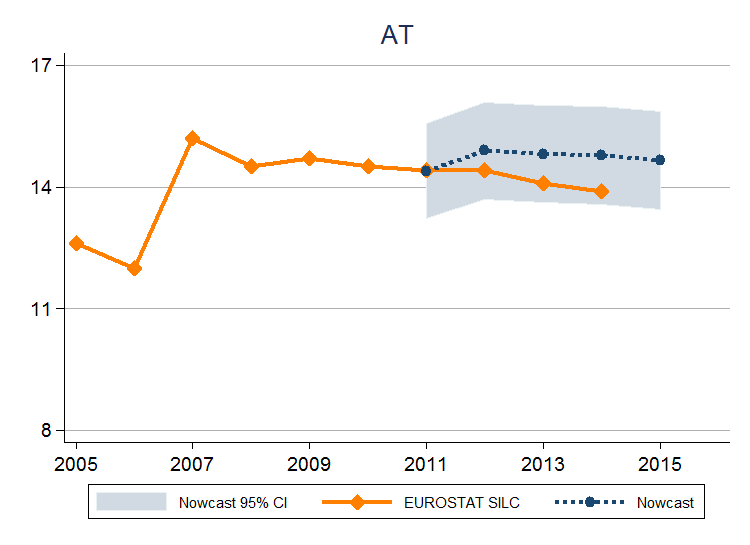


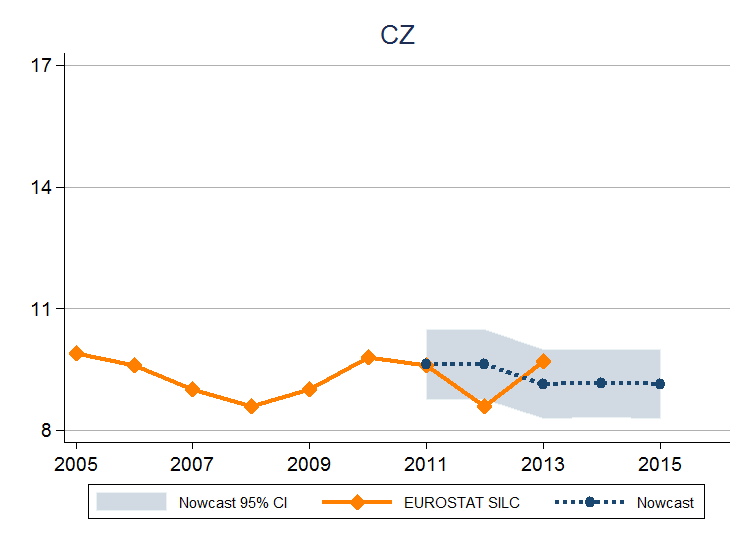

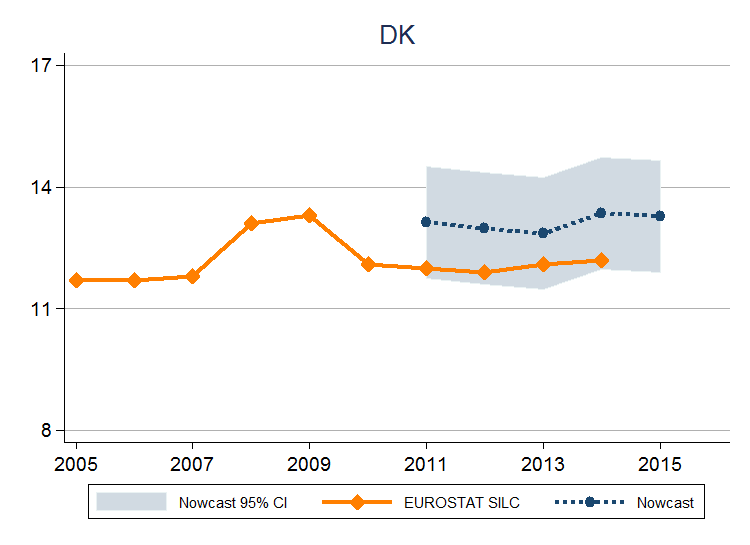









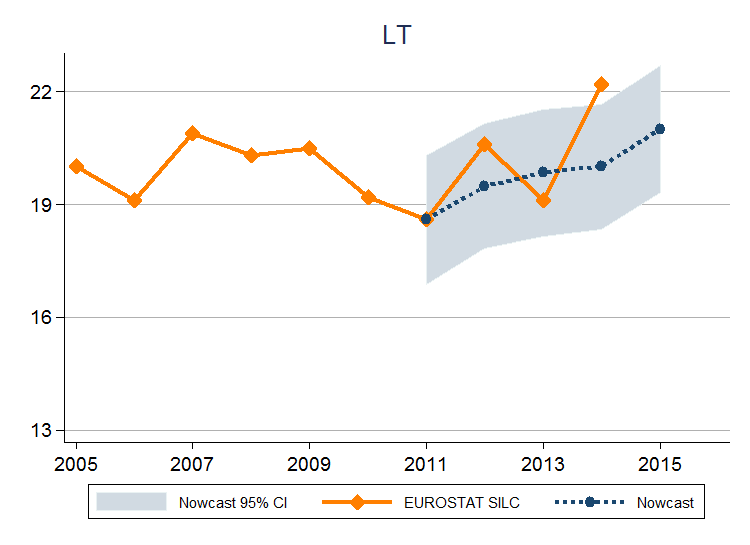

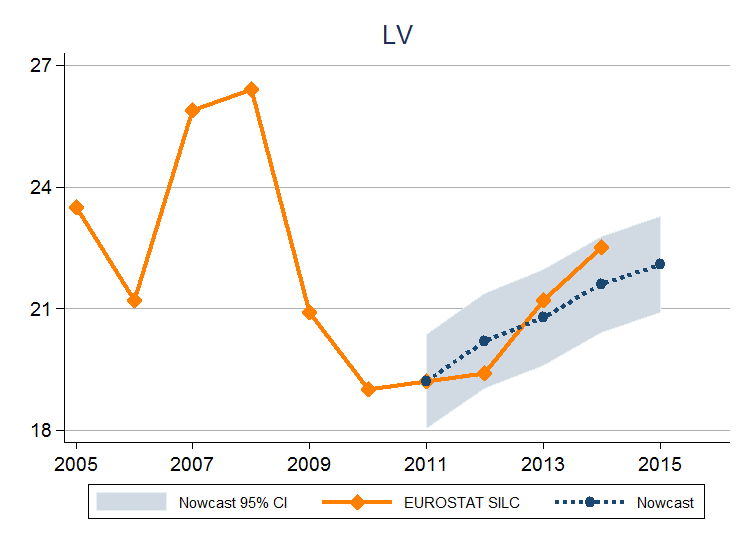



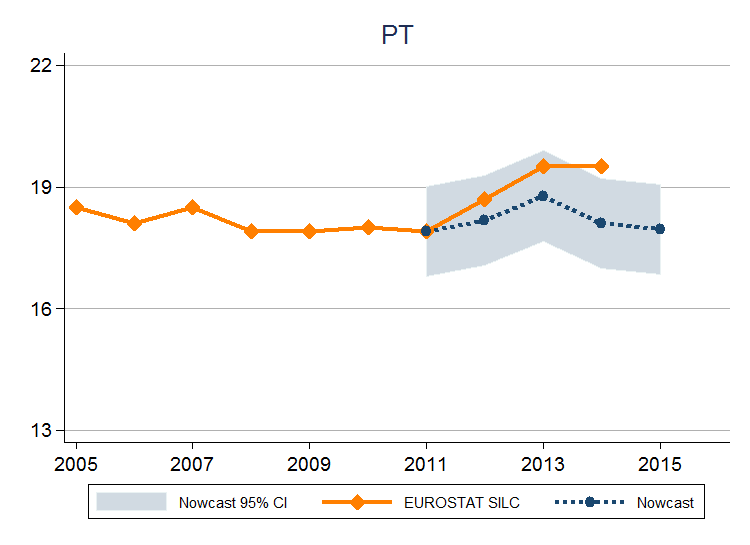



Source: own simulations with EUROMOD; Eurostat database (last accessed on August 17, 2016)
The nowcasting approach constitutes a sound alternative to waiting until official statistics are made available and can provide valuable ex-ante information on potential distributional effects of contemporary economic and policy-related developments. The method is transparent and consistent across countries. The methodology is continuously improved based on retrospective assessment of nowcasts’ performance.
More information
The nowcasts up to 2016 for all EU countries are expected to be released in spring 2017. The presented and upcoming results are based on research carried out within the ‘EU Social Situation Monitor’.
To read more about the nowcasts for 2015, see the EUROMOD Working Paper.

